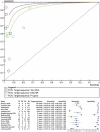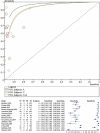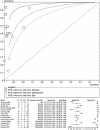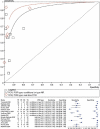PCR versus serology for diagnosing Mycoplasma pneumoniae infection: a systematic review & meta-analysis
- PMID: 21985809
- PMCID: PMC3193707
PCR versus serology for diagnosing Mycoplasma pneumoniae infection: a systematic review & meta-analysis
Abstract
Background & objectives: Diagnosis for Mycoplasma pneumoniae usually relies on serological tests. PCR technology has some advantages but also limitations. The optimal selection for these tests still needs discussion. This paper reviews the overall diagnostic accuracy of PCR versus serological assays for diagnosis of M. pneumoniae infections and to identify factors associated with heterogeneity of results.
Methods: MEDLINE and Embase databases were searched. Articles meeting the selection criteria were retrieved for data collection and analysis. Studies were assessed for methodological quality using QUADAS. Hierarchial summary receiver operating characteristic (HSROC) model was used to estimate summary ROC curve.
Results: Initial meta-analysis showed a summary estimate of sensitivity (SEN) 0.62 (95% CI, 0.45-0.76), and specificity (SPE) 0.96 (95% CI, 0.93-0.98). Subgroup analyses were performed to identify factors associated with heterogeneity. For different gene targets, reference standards, subjects (children or adults) and different PCR types, these aspects can generate results of heterogeneity. The 16s rDNA target and adult subjects and real-time PCR may have better test results for PCR.
Interpretation & conclusions: Commercial PCR tests generated consistent results with high specificity but a lower and more variable sensitivity. The findings suggest commercial PCR tests having superiorities in diagnosing M. pneumoniae infections but still cannot replace serology. PCR plus serology could be good screening tests for reliable and accurate diagnosis of M. pneumoniae.
Conflict of interest statement
Figures









Similar articles
-
Non-invasive diagnostic tests for Helicobacter pylori infection.Cochrane Database Syst Rev. 2018 Mar 15;3(3):CD012080. doi: 10.1002/14651858.CD012080.pub2. Cochrane Database Syst Rev. 2018. PMID: 29543326 Free PMC article.
-
Clinical symptoms and signs for the diagnosis of Mycoplasma pneumoniae in children and adolescents with community-acquired pneumonia.Cochrane Database Syst Rev. 2012 Oct 17;10(10):CD009175. doi: 10.1002/14651858.CD009175.pub2. Cochrane Database Syst Rev. 2012. PMID: 23076954 Free PMC article.
-
Signs and symptoms to determine if a patient presenting in primary care or hospital outpatient settings has COVID-19.Cochrane Database Syst Rev. 2022 May 20;5(5):CD013665. doi: 10.1002/14651858.CD013665.pub3. Cochrane Database Syst Rev. 2022. PMID: 35593186 Free PMC article.
-
Antibody tests for identification of current and past infection with SARS-CoV-2.Cochrane Database Syst Rev. 2022 Nov 17;11(11):CD013652. doi: 10.1002/14651858.CD013652.pub2. Cochrane Database Syst Rev. 2022. PMID: 36394900 Free PMC article.
-
Symptom- and chest-radiography screening for active pulmonary tuberculosis in HIV-negative adults and adults with unknown HIV status.Cochrane Database Syst Rev. 2022 Mar 23;3(3):CD010890. doi: 10.1002/14651858.CD010890.pub2. Cochrane Database Syst Rev. 2022. PMID: 35320584 Free PMC article.
Cited by
-
Characteristics of the Mycoplasma pneumoniae Epidemic from 2019 to 2020 in Korea: Macrolide Resistance and Co-Infection Trends.Antibiotics (Basel). 2023 Nov 13;12(11):1623. doi: 10.3390/antibiotics12111623. Antibiotics (Basel). 2023. PMID: 37998825 Free PMC article.
-
A diagnostic host-specific transcriptome response for Mycoplasma pneumoniae pneumonia to guide pediatric patient treatment.Nat Commun. 2025 Jan 15;16(1):673. doi: 10.1038/s41467-025-55932-9. Nat Commun. 2025. PMID: 39809748 Free PMC article.
-
Guidelines for diagnosis and management of community- and hospital-acquired pneumonia in adults: Joint ICS/NCCP(I) recommendations.Lung India. 2012 Jul;29(Suppl 2):S27-62. doi: 10.4103/0970-2113.99248. Lung India. 2012. PMID: 23019384 Free PMC article. No abstract available.
-
Bullous Skin Manifestations of Mycoplasma pneumoniae Infection: A Case Series.J Investig Med High Impact Case Rep. 2017 Sep 8;5(3):2324709617727759. doi: 10.1177/2324709617727759. eCollection 2017 Jul-Sep. J Investig Med High Impact Case Rep. 2017. PMID: 28959692 Free PMC article.
-
Epidemiological comparison of three Mycoplasma pneumoniae pneumonia epidemics in a single hospital over 10 years.Korean J Pediatr. 2015 May;58(5):172-7. doi: 10.3345/kjp.2015.58.5.172. Epub 2015 May 22. Korean J Pediatr. 2015. PMID: 26124847 Free PMC article.
References
-
- Gil JC, Cedillo RL, Mayagoitia BG, Paz MD. Isolation of Mycoplasma pneumoniae from asthmatic patients. Ann Allerg. 1993;70:23–5. - PubMed
-
- Lieberman D, Schlaeffer F, Lieberman D, Horowitz S, Horovitz O, Porath A. Macoplasma pneumoniae community-acquired pneumonia: a review of 101 hospitalized adult patients. Respiration. 1996;63:261–6. - PubMed
-
- Gomez J, Banos V, Ruiz Gomez J, Soto MC, Munoz L, Nunez ML, et al. Prospective study of epidemiology and prognostic factors in community-acquired pneumonia. Eur J Clin Microbiol Infect Dis. 1996;15:556–60. - PubMed
-
- Varma-Basil M, Dwivedi SK, Kumar K, Pathak R, Rastogi R, Thukral SS, et al. Role of Mycoplasma pneumoniae infection in acute exacerbations of chronic obstructive pulmonary disease. J Med Microbiol. 2009;58:322–6. - PubMed
-
- Walter ND, Grant GB, Bandy U, Alexander NE, Winchell JM, Jordan HT, et al. Community outbreak of Mycoplasma pneumoniae infection: school-based cluster of neurologic disease associated with household transmission of respiratory illness. J Infect Dis. 2008;198:1365–74. - PubMed
Publication types
MeSH terms
Substances
LinkOut - more resources
Full Text Sources
